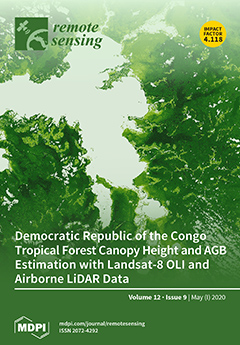The accurate remote estimation of the Secchi disk depth (Z
SD) in turbid waters is essential in the monitoring the ecological environment of lakes. Using the field measured Z
SD and the remote sensing reflectance (Rrs(λ)) data, a new semi-analytical algorithm (denoted
[...] Read more.
The accurate remote estimation of the Secchi disk depth (Z
SD) in turbid waters is essential in the monitoring the ecological environment of lakes. Using the field measured Z
SD and the remote sensing reflectance (Rrs(λ)) data, a new semi-analytical algorithm (denoted as Z
SDZ) for retrieving Z
SD was developed from Rrs(λ), and it was applied to Geostationary Ocean Color Imager (GOCI) images in extremely turbid waters. Our results are as follows: (1) the Z
SDZ performs well in estimating Z
SD in turbid water bodies (0.15 m < Z
SD < 2.5 m). By validating with the field measured data that were collected in four turbid inland lakes, the determination coefficient (R
2) is determined to be 0.89, with a mean absolute square percentage error (MAPE) of 22.39%, and root mean square error (RMSE) of 0.24 m. (2) The Z
SDZ improved the retrieval accuracy of Z
SD in turbid waters and outperformed the existing semi-analytical schemes. (3) The developed algorithm and GOCI data are in order to map the hourly variation of Z
SD in turbid inland waters, the GOCI-derived results reveal a significant spatiotemporal variation in our study region, which are significantly driven by wind forcing. This study can provide a new approach for estimating water transparency in turbid waters, offering important support for the management of inland waters.
Full article





